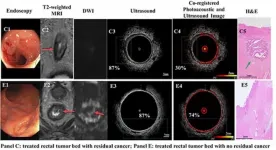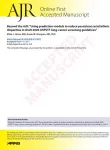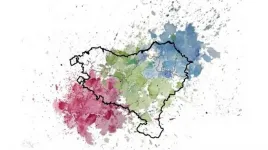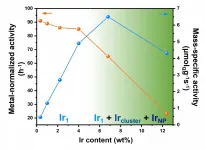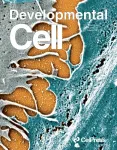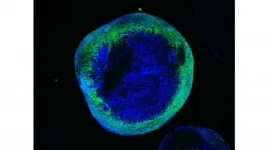Discovery of a third T cell lineage
2021-03-26
(Press-News.org) The immune systems of all vertebrates contain specialized cells, called T cells, that play a fundamental role in protecting against fungal, bacterial, parasitic and viral infections. T cells use 'molecular sensors' called T cell receptors (TCRs) on their surface that can detect and eliminate the invading pathogens. For most of the past four decades, it was considered that there were only two T cell lineages, αβ and γδ T cells, characterized by their cell surface expressed αβ and γδ TCRs, respectively.
In a paper published today in Science, an international team of scientists at the University of New Mexico (US), Monash University (Australia), and the US National Institutes of Health, has defined a novel T cell lineage, called γμ T cells, found only in marsupials (e.g. kangaroos and opossums) and monotremes (e.g. duckbill platypus).
Evidence for the γμ TCR came with the discovery of genes encoding the TCRμ protein whilst analyzing the first complete marsupial genome, that of the South American opossum Monodelphis domestica. Oddly, distinct from conventional αβ and γδ TCRs, TCRμ was predicted to share similarity with the antibodies.
Using the Australian Synchrotron, the scientists at Monash University obtained a detailed three-dimensional image of the opossum γμTCR architecture that was unique and distinct from αβ or γδ TCRs. Noteworthy was the presence of an additional single antibody-like segment called Vμ domain with an architecture resembling to nanobodies, a unique type of antibodies. This discovery raises the possibility that γμ T cells recognize pathogens using novel mechanisms, distinct from conventional T cells.
"The discovery of a nanobody like structure in the γμ TCR has the potential to expand the immunology 'toolbox'. Indeed, nanobodies discovered in the camel family (e.g. alpacas) have recently attracted considerable interests for their development as research and diagnostic tools and more importantly as immunotherapeutics in humans to combat cancer and viral infections such as COVID-19. Marsupials may offer an alternative source of nanobodies, one that is smaller, easier and cheaper to maintain than llamas or alpacas." said Monash University Dr Marcin Wegrecki from the Biomedicine Discovery Institute, co-first author on the paper.
"Our findings further illustrate the value of exploring the world's biodiversity for novelty beyond the standard animal research models, such as laboratory mice. Modern genomic tools applied to many species have opened the door to the myriad of immunological solutions to fighting pathogens that evolution has produced." said Prof Robert Miller from the University of New Mexico, co-lead author on the paper.
"Many in-roads have been made in understanding the immune systems of humans and mice leading to the development of novel immunotherapeutic approaches enabling humans to combat highly pathogenic viruses. However, much less is understood on how immunity operates in other species that, in some cases, have been decimated by wildlife diseases. Ultimately our work may guide the development of veterinary approaches (e.g. novel vaccines) that will contribute to wildlife conservation." said Dr Jérôme Le Nours from Monash Biomedicine Discovery Institute, co-lead author on the paper.
"This is a prime example of curiosity driven science leading to unexpected and transformative findings." Le Nours stated.
INFORMATION:
The research findings were a culmination of a 12-year project that involved a multidisciplinary collaborative effort and the support from the ARC Centre of Excellence in Advanced Molecular Imaging, and funding from the US National Science Foundation, the US National Institutes of Health and the Australian Research Council.
Read the full paper in Science entitled: The molecular assembly of the marsupial γμ T cell receptor defines a third T cell lineage.
DOI: 10.1126/science.abe7070
About the Monash Biomedicine Discovery Institute at Monash University
Committed to making the discoveries that will relieve the future burden of disease, the newly established Monash Biomedicine Discovery Institute at Monash University brings together more than 120 internationally-renowned research teams. Spanning six discovery programs across Cancer, Cardiovascular Disease, Development and Stem Cells, Infection and Immunity, Metabolism, Diabetes and Obesity, and Neuroscience, Monash BDI is one of the largest biomedical research institutes in Australia. Our researchers are supported by world-class technology and infrastructure, and partner with industry, clinicians and researchers internationally to enhance lives through discovery.
For Media Enquiries please contact:
E: wendy.smith1@monash.edu
T: +61 (0) 425 725 836
For more Monash media stories, visit our news and events site
[Attachments] See images for this press release:
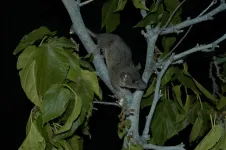
ELSE PRESS RELEASES FROM THIS DATE:
2021-03-26
Renewable energy demand and consumption is at an all-time high in the United States.
Shrub willow - a quick-growing woody crop - can be an excellent source of renewable bioenergy. The crop is harvested and turned into wood chips, which can be used for heat, mulch, animal bedding, biochar, and biofuel.
In a new study, researchers grew shrub willow on a semi-commercial scale to better understand the nuances of this bioenergy crop. The research was published in Agronomy Journal, a publication of the American Society of Agronomy.
"We learned and developed key know-hows that we can transfer to industry partners interested in this crop," says Armen Kemanian. Kemanian is a member of the American Society of Agronomy and is the ...
2021-03-26
Rectal cancer, along with colon cancer, is the third-most common type of cancer in the United States, and treatment and surgery greatly affect the quality of life of patients. A multi-disciplinary team at Washington University in St. Louis has developed and tested an innovative imaging technique that is able to differentiate between rectal tissues with residual cancers and those without tumors after chemotherapy and radiation, which could one day help to avoid unnecessary surgeries in some patients who have achieved complete tumor destruction after chemoradiation.
Quing Zhu, PhD, professor of biomedical engineering at the McKelvey School of Engineering, and members of her lab developed ...
2021-03-26
The Institute for Quality and Efficiency in Health Care (IQWiG) revised its methods paper and published the German original version "Allgemeine Methoden 6.0" (General Methods 6.0) on http://www.iqwig.de in November 2020. This document is the basis for the scientific work of the Institute and its external experts as well as for the collaboration with its contracting agencies, the Federal Joint Committee (G-BA) and Federal Ministry of Health (BMG). The English translation is now available on http://www.iqwig.de/en/about-us/methods/methods-paper/.
New features include statements on the investigation of the relationship between volume of services and quality, a section on different treatment periods in studies, and a more concrete approach to the assessment of clinical relevance.
In ...
2021-03-26
Scientists have developed a method to use lasers to control the movement of nanodiamonds with fluorescent centers.
Scientists have long been working on improving their ability to use lasers to move small objects without actually touching them. This method of 'optical trapping and manipulation' is already utilized in optics, biological sciences and chemistry. But objects become much more difficult to control once they grow to nanoscale size.
Now, a team of scientists including Hokkaido University's Keiji Sasaki and Osaka Prefecture University ...
2021-03-26
Leesburg, VA, March 26, 2021--According to ARRS' American Journal of Roentgenology (AJR), updated United States Preventive Services Task Force (USPSTF) lung cancer screening (LCS) guidelines based solely on age, pack-years, and quit-years perpetuate eligibility disparities among racial and ethnic minorities, although incorporating certain risk prediction models may help reduce such inequalities.
By pulling data from the 2015 National Health Interview Survey (NHIS), Journal of the National Cancer Institute researchers (Landy et al.) were able to "estimate the effects of USPSTF-2020 guidelines on disparities in LCS eligibility for the non-institutionalized civilian US population," wrote Massachusetts ...
2021-03-26
The Basques are a unique population in Western Europe; their language is not related to any Indo-European language. Furthermore, genetically speaking, they have been considered to have distinct features. However, until now there was no conclusive study to explain the origin of their singularity.
Now, an international research team led by UPF has confirmed that the Basques' genetic uniqueness is the result of genetic continuity since the Iron Age, characterized by periods of isolation and scarce gene flow, and not its external origin in respect of other Iberian populations.
The study, led by David Comas, principal investigator at UPF and at the Institute of Evolutionary Biology (IBE: CSIC-UPF), has involved ...
2021-03-26
Atomically dispersed catalysts have received extensive research attention, because they exhibit excellent activity and unique selectivity for many important catalytic reactions. The atomically dispersed nature of these metal catalysts confers their unique electronic structures as well as designated coordination-unsaturated environments for the optimized adsorption/activation of the reactants. One grand challenge faced by these atomically dispersed catalysts is that the supported isolated metal \atoms are usually thermally unstable and tend to aggregate into large clusters/particles at evaluated reaction temperatures. As a result, most reported atomically dispersed catalysts have an extremely low metal loading below ...
2021-03-26
Every year, millions of people around the world are displaced from their homes due to severe weather caused by climate change. According to the International Red Cross and Red Crescent Movement, 10.3 million people were displaced as a result of climate-?related events in the last six months alone - four times the number displaced by war and conflict in the same period. One of the main causes of displacement is flooding. A recent example is the situation in eastern Australia, where tens of thousands of people are having to flee their homes to seek safety from this hundred-?year flood.
An international research team led by the Weather ...
2021-03-26
The skin is the largest organ in the human body, and its outermost part, called the epidermis, is replenished every three weeks. The cells fueling this renewal of the epidermal stem cells, found in specialized areas or niche, within a region of the hair follicle (or root) is known as the 'bulge compartment'. The bulge compartment resident stem cells are multipotent meaning that they can contribute to the repair of skin when it's injured, and also regenerate the hair follicles during normal development. While several groups have focused attention on the stem cells themselves, less is known about niche or extrinsic factors that influence the state of these stem cells.
In the recent paper published in the Developmental Cell, ...
2021-03-26
Leigh syndrome is the most severe mitochondrial disease in children. It causes severe muscle weakness, movement defects, and intellectual disabilities. It usually leads to death within the first years of life. No causative treatment is currently available. One of the genes frequently mutated in patients is SURF1, which encodes for a protein involved in the process of energy generation in the cells. Animal models did not recapitulate the defects seen in the patients carrying mutations in SURF1. Therefore, the scientists did not have the tool to start understanding the disease mechanisms and to identify possible targets for treatment. They report about the first ...
LAST 30 PRESS RELEASES:
[Press-News.org] Discovery of a third T cell lineage


